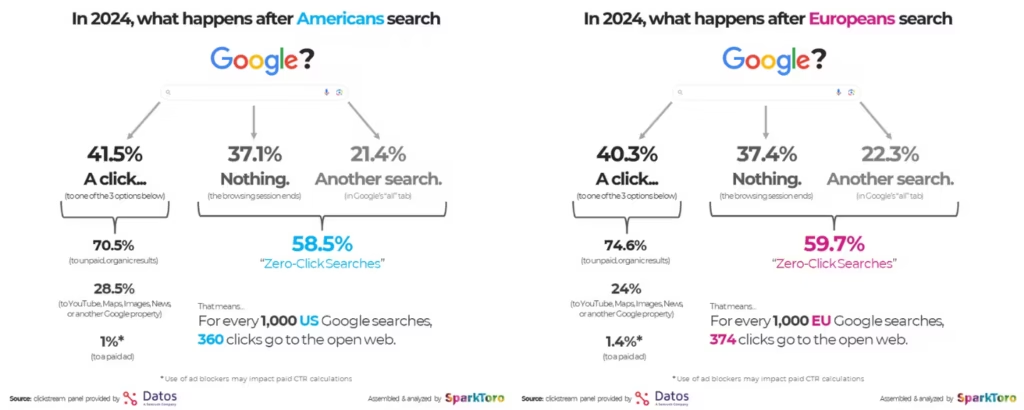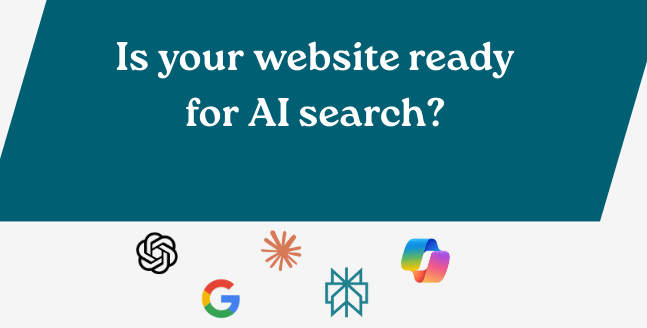There’s been a lot of change in how buyers search online, and with this change, businesses are being impacted. With ChatGPT Search and AI Overviews in Google search providing summarized answers to user queries, websites are getting less traffic compared to the pre-AI era.
According to SparkToro data from the US and EU—the most tracked markets—in 2024, 58.5% of Google searches in the US and 59.7% in the EU ended without a click. This reality, known as zero-click searches, indicates that users are increasingly relying on the information provided by search engines without visiting external websites.

Source: SparkToro
This however doesn’t mean that websites aren’t getting traffic from AI search engines and assistants. These tools do send traffic to websites; and there’s enough data proving this.
For instance, a Feb 2025 Ahrefs study of 3,000 websites shows that 63% of websites receive AI traffic. According to the study, most of this traffic came from ChatGPT Search.

Source: Ahrefs
So, AI search engines are sending traffic to websites, but at the same time, their summarized answers mean fewer clicks on website links.
It’s obvious that AI-powered search results enhance user experience, but what’s the impact for businesses?
Traditional SEO vs. AI Search
For a long time, traditional SEO has been the cornerstone of organic digital visibility. To win in SEO, you needed to focus on keywords, build links, and get technical SEO right. But with AI, everything changes.
Instead of keywords, AI uses machine learning, natural language processing, and advanced data analytics to understand user intent. AI comprehends context and even processes visual content alongside text. This means that B2B brands must adapt their content strategies to attain and/or retain visibility and relevance.
Here are three key differences between traditional SEO and AI Search:
- Information processing and delivery: While traditional search engines display a list of links that users click through to websites, AI solutions like Google’s AI Overviews and Microsoft’s Copilot often display summarized answers in search results.
- Content evaluation criteria: Instead of focusing on keywords, backlinks, and technical SEO, AI-powered search engines prioritize content depth, accuracy, authority, structure, and alignment with user intent.
- Adaptability: Since AI search engines are powered by machine learning and advanced data analytics, they’re always learning from user interactions and can easily and quickly respond to emerging topics and shifting preferences.
What Challenges Do B2B Brands Face in the Era of AI Search?
With the gradual shift in search preferences, B2B brands and marketers face the following challenges:
1. Reduced Website Traffic
As AI search engines provide direct answers in search results, B2B websites may experience reduced traffic. This will happen despite maintaining high relevance for queries, making traditional SEO metrics less useful.
That said, the quality of the traffic coming from AI search engines is noticeably high.
While AI search engines may drive less traffic overall, the value of that traffic is significantly higher than traditional search. Visitors arriving via AI search are often much further along in their buyer journey — ready to take action.
— Erik Wikander
This calls for a strong lead capture and nurturing strategy that ensures the high-value traffic doesn’t go to waste. Check out our email marketing article to learn how to use email to nurture leads from AI search results.
2. Need to Prove Authority
AI search engines prioritize authoritative content that demonstrates expertise. For B2B brands to establish and maintain this authority, they’ll need strong subject matter expertise and a proactive approach to content distribution and promotion.
3. Structured Data Requirements
Since AI systems rely heavily on structured data to understand and categorize content, B2B websites will need to implement proper schema markup. Without structured data, these websites may find their content overlooked or misinterpreted by AI search engines.
4. Balancing Human and AI Search Engine Needs
Balancing between human and AI needs is another challenge. While human readers will want engaging and helpful content, AI will want structure, clarity, and accuracy. Striking this balance can be challenging as it requires knowledge, care, and effort.
How To Optimize Website Content for AI Search
Optimizing your website content for AI search engines is necessary if you’re to get AI mentions and referral traffic. Since these tools understand context and user intent, follow these seven actionable steps to boost your site’s visibility in AI search results.
Short on time? Download the checklist.
1. Structure Content for Speed, Clarity, and Machine Readability
AI search engines love fast, structured, and semantically rich content. To boost your chances of being featured in their results, do the following:
- Use standard HTML or Markdown, and avoid excessive use of JavaScript.
- Structure your content logically and use proper heading hierarchies, i.e. H1 – H6.
- Ensure your site loads fast, ideally in less than 1 second, with the most important information placed high on the page.
2. Implement Semantic Markup and Metadata
Semantic markup and metadata helps AI tolls understand the context of your content. To help with this, ensure you add relevant titles, meta descriptions, and Open Graph tags for visibility across different platforms.
Also, use structured data (JSON-LD) to describe articles, FAQs, products, etc.
3. Optimize for Conversational and Semantic Search
Since AI systems mimic how people ask questions in real life, they prioritize content that answers questions in a human style. To benefit from this, ensure you:
- Target natural-language queries and long-tail keywords.
- Use semantically connected terms to create deep and relevant contexts.
- Include direct answers to common questions.
4. Ensure Discoverability by AI Search Engine Crawlers
Before even thinking about being cited by AI, you need to ensure your content is crawlable by AI bots. Here’s what to do:
- Ensure your robots.txt file allows crawling by AI-specific agents.
- Avoid aggressive bot blocking at the firewall or CDN level.
- Keep your internal link structure crawlable and avoid JavaScript-only navigation elements.
5. Prioritize Content Quality and Topical Authority
AI search engines are designed to show trustworthy, expert-level content. For your content to fit that category, create content clusters that build topical authority around your area of expertise.
If you’re already doing B2B blogging and have published some articles, update them with new insights, preferably from recent statistics.
6. Optimize for AI Search Results Snippets and Featured Answers
AI systems like quotable content—something that human readers also love. To optimize for this, do the following:
- Break down insights using bullet points, tables, and concise summaries.
- Include standalone answers to common questions near the top of the page.
- Add well-structured FAQs that reflect how people ask questions.
Pro Tip: By implementing these formatting tweaks, you also improve your chances of being included in the “People Also Ask” results.
7. Use Diverse Content Formats
While AI processes text very well, it’s increasingly processing multimedia content well too. Since human audiences also love visual content, add infographics, charts, and even original videos to your content.
For image, remember to add descriptive alt text to help AI interpret the images.
Above all, understand that AI optimization isn’t about chasing trends. It’s more about aligning your website content with how people think, search, and develop trust in an AI-augmented world.
Conclusion
While AI is changing how search works, it’s not killing traffic entirely. However, with this change, the brands that adapt quickly—publishing content suitable for both humans and machines—will win in the long-term.
The good news is, with an understanding of how AI search works and a good strategy, your business won’t play catch-up. If you need help optimizing your site or blog for AI visibility and performance, talk to us.

